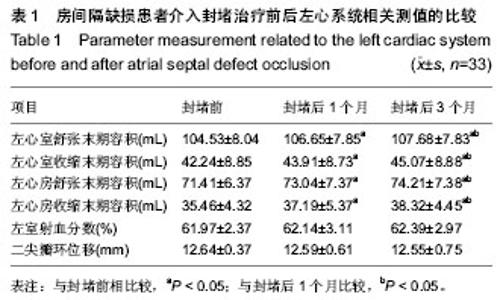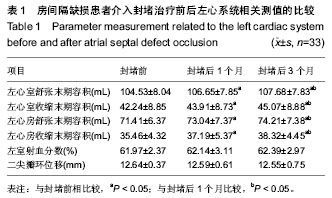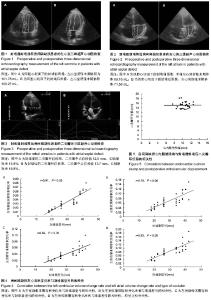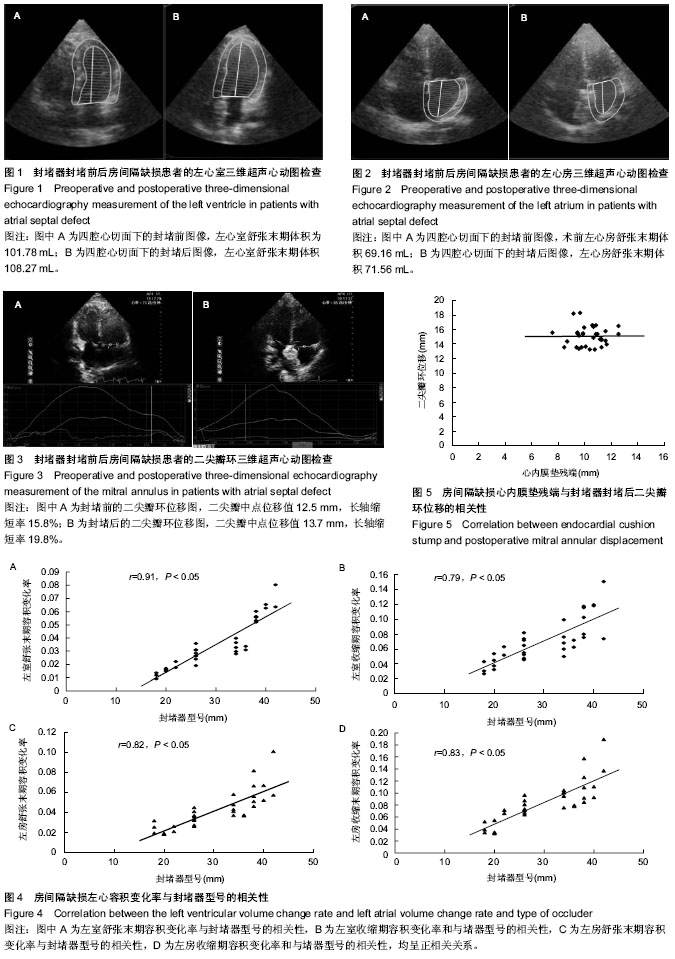| [1] 王延震,谢静,谢定雄,等.Amplatzar封堵器的生物学性能及经导管介入治疗房间隔缺损[J].中国组织工程研究与临床康复, 2007, 11(1):25-28.
[2] 孙菲菲,任卫东.实时三维经食管超声心动图在房间隔缺损诊断及介入治疗中的应用进展[J].中国介入影像与治疗学, 2011,1(1): 58.
[3] Gao Z,Xu B,Kirtane AJ,et al.Impact of depressed left ventricular function on outcomes in patients with three—vessel coronary disease undergoing percutaneous coronary interventionChin Med J (Engl).2013;126(4):609-614.
[4] 钟卫华,颜程光.超声心动图对封堵器治疗的安全性和有效性评价[J].中国组织工程研究与临床康复,2008,12(35):6938-6940.
[5] 朱永新,徐晓东,刘少忠,等.国产封堵器介入治疗先天性心脏病20例临床分析[J].安徽医药,2010,14(2):190-194.
[6] 王志远,金梅.Amplatzer与国产封堵器经皮介入治疗室间隔缺损的临床应用现状[J].心肺血管病杂志,2010,29(1):77-80
[7] 纪军,何胜虎,徐日新,等.经胸联合经食道超声心动图在成人房间隔缺损介入封堵术中的临床价值[J].海南医学院学报, 2012, 18(3): 128.
[8] 王茜,郭盛兰,覃诗耘,等.经胸超声心动图评价年龄对房间隔缺损患者封堵术后预后的影响[J].中国超声医学杂志, 2014,30(4): 332-336
[9] 杨天和,杨永曜,蒋清安,等.不同年龄段房间隔缺损封堵对心脏重构及心功能的影响[J].中国组织工程研究与临床康复, 2009, 13(39): 7707-7710.
[10] 丁守良,张磊,惠增骞,等.国产封堵器介入治疗动脉导管未闭93例:疗效及安全性评价[J].中国组织工程研究与临床康复, 2007, 11(25): 4966-4968.
[11] 解启莲,王军,闫宝勇,等.封堵器置入部位与室间隔缺损治疗后的心律失常[J].中国组织工程研究与临床康复, 2008,12(9): 1618-1620.
[12] 叶军明,谢海玉,钟钦文,等.心脏封堵器置入过程中麻醉相关问题对生物相容性的影响田[J].国组织工程研究与临床康复, 2008, 12(52):10339-10342
[13] Moceri P,Doyen D,Bertora D,et al.Real time three-dimensional echocardiographic assessment of left ventricular function in Heart failure patients:underestimation of left ventricular volume increases with the degree of dilatation.Echocardiography.2012;29(8):970-977.
[14] 殷哲煜,刘宏宇,张国伟,等.经胸超声心动图对非体外循环房间隔缺损封堵术的作用[J].中国医学影像技术,2007,23(2):251-253.
[15] 吴田,郭瑞强,陈金玲,等.超声心动图评价肥厚型心肌病和高血压左心室肥厚患者左心房收缩功能[J].中国医学影像技术, 2010, 26(增刊1):154.
[16] 王新房.超声心动图学[M].北京:人民卫生出版社,20l2:625-626.
[17] 范莉,颜紫宁,芮逸飞,等.实时三维超声心动图对比评价正常右心室及左心室功能[J].中国医学影像技术,2012,28(10): 1827-1830.
[18] Jenkins C,Bricknell K,Marwick TH.Use of real-time three-dimensional echocardiography to measure left atrial volume: comparison with other echocardiographic techniques.J Am Soc Echocardiogr.2005;18(9):991-997.
[19] Mor-Avi V,Lang RM.The use of real-time three-dimensional echocardiography for the quantification of left ventricular volumes and function.Curr Opin Cardiol. 2009;24(5):402-409.
[20] 黄莺,郭盛兰,覃诗耘,等.实时三维超声心动图对房间隔缺损患者左室收缩功能的评价[J].中国超声医学杂志,2010,26(8): 713-715.
[21] 周立明,周青,郭瑞强,等.经胸超声心动图引导Amplatzer封堵器经心导管封堵房间隔缺损及疗效观察[J].中国医学影像技术, 2006,22(11):1733-1735.
[22] 王玥,杨军,杨光,等.单心动周期实时三维超声心动图评价房间隔缺损患者左心室收缩同步性[J].中华超声影像学杂志, 2012, 21(2): 175-177.
[23] Herberg U,Gatzweiler E,Breuer T,et al.Ventricular pressure-volume loops obtained by 3D real-time echocardiography and mini pressure wire-a feasibility study.Clin Res Cardiol.2013;102(6):427-438.
[24] 杨光,任卫东,王立建,等.应用左、右心室舒张末期内径比值判断房间隔缺损封堵术后随访终点[J].中国介入影像与治疗学, 2012, 9(2):79-82.
[25] 王建华,刘昕,巩晓红.二维斑点追踪技术测量二尖瓣环位移评价左心室整体收缩功能的新方法[J].中国医学影像技术, 2009, 25(9):1604-1606.
[26] 拓胜军,刘丽文,张建蕾,等.组织运动瓣环位移技术定量评价单纯腹型肥胖患者左心室长轴收缩功能[J].中华超声影像学杂志, 2012,21(5):373-377.
[27] 刘表虎,王全师,朱向明,等.实时三维超声节段收缩非同步指数评价慢性心功能不全患者左室非同步运动与收缩功能的关系[J].南方医科大学学报,2012,32(8):1122-1126.
[28] Roberson DA,Cui W,Patel D,et al.Three-dimensional transesophageal echocardiography of atrial septal defect:a qualitative and quantitative anatomic study.J Am Soc Echocardiogr.2011;24(6):600-610.
[29] 谭静,俞杉,吴强,等.实时三维经胸超声心动图评价右室不同部位起搏对左室收缩同步性和收缩功能的影响[J].中国医学影像学杂志,2012,20(3):208-211.
[30] Rahman F,Salman M,Akhter N,et al.Pattern of congenital heart diseases.Mymensingh Med J.2012;21(2):246-250.
[31] 李阳,邓又斌,黄润青,等.实时三维超声心动图斑点追踪技术评价扩张型心肌病患者左室收缩功能[J].临床超声医学杂志, 2013, 26(6):369-372.
[32] Buss SJ,Mereles D,Emami M,et al.Rapid assessment of longitudinal systolic left ventricular function using speckle tracking of the mitral annulus.Am J Cardiol. 2011;24(11): 1004-1005.
[33] Giardini A,Donti A,Formigari R,et al.Determinants of cardiopulmonary functional improvement after transcatheter atrial spetal defect closure in asymptomatic adults.Am J Cardiol. 2004;43(10):1886-1891.
[34] 张宏,施红,卫张蕊,等.实时三维经食管超声心动图在成人房间隔缺损介入封堵术中的应用[J].中国介入影像与治疗学, 2013, 10(5):294.
[35] 赵国强,金仁波,尹慧娟,等.经胸超声心动图在儿童特殊类型房间隔缺损封堵中的应用价值[J].中国现代医学杂志, 2013,23(9): 92. |



